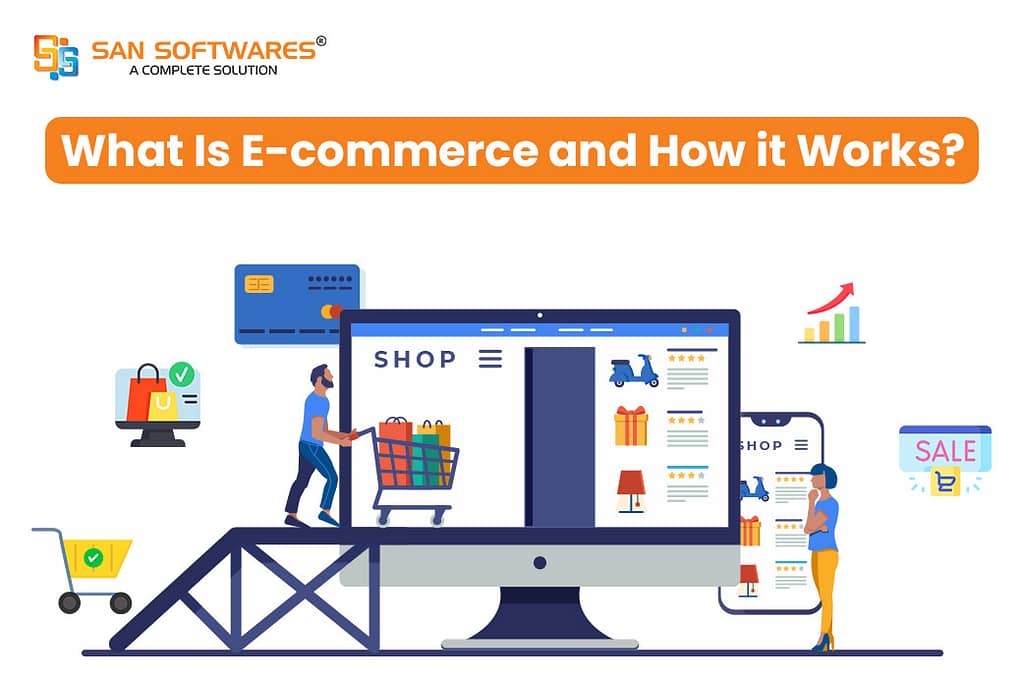E-commerce is not just a trend; it’s a fundamental shift in how we do business. With the global market growing at an incredible rate, starting an e-commerce website is a powerful way to build a profitable business. But where do you start? And what are the different ways you can actually earn money from an online store?
This guide breaks down the core business models and proven strategies to help you navigate the world of e-commerce and start generating revenue.

The Foundation: E-commerce Business Models
Before you can earn, you need a business model. This is the blueprint for how your store will operate and generate revenue. The most common models include
1. Selling Products (Direct-to-Consumer)
This is the most traditional e-commerce model. You create, source, or manufacture your own products and sell them directly to customers through your website. This gives you complete control over your brand, pricing, and customer experience.
- Benefits: high-profit margins, full brand control, and customer loyalty.
- Corn: Requires significant upfront capital for inventory and requires managing all aspects of the supply chain (storage, shipping, etc.).
2. Dropshipping
Dropshipping is a low-risk, low-inventory model. You list products on your website, but you don’t hold any inventory yourself. When a customer places an order, you forward it to a third-party supplier who ships the product directly to the customer.
- Pros: Very low startup costs, no need for a warehouse or inventory management, easy to test new products.
- Cons: Lower profit margins, less control over shipping and product quality, can be highly competitive.
3. Print-on-Demand
Similar to dropshipping, print-on-demand allows you to sell custom-designed products (like t-shirts, mugs, or posters) without managing inventory. You partner with a print-on-demand company that prints your design on the product and ships it to the customer only after an order is placed.
- Pros: Minimal risk and investment, creative freedom, great for artists and content creators.
- Cons: Lower margins than direct-to-consumer, reliance on your supplier for quality and shipping times.
4. White Labeling and Private Labeling
White labeling involves buying generic, pre-made products from a supplier and rebranding them with your own logo and packaging. Private labeling is a step further, where you hire a manufacturer to create a product exclusively for your brand based on your specifications.
- Pros: Faster to market than creating a product from scratch, a way to build your own brand.
- Cons: Less unique products (white label), can be more expensive (private label), still requires managing inventory.

5. Affiliate Marketing
You don’t need to sell a single product to make money from an e-commerce website. With affiliate marketing, you earn a commission by promoting other people’s products. You create content (like blog posts or reviews) with special links. When a user clicks your link and makes a purchase, you get a percentage of the sale.
- Pros: No inventory to manage, passive income potential, low-risk.
- Cons: Income is dependent on commissions; you don’t control the product or customer experience.
The Strategy: How to Maximize Your E-commerce Revenue
Once you’ve chosen your model, the real work begins. Earning money from your website is all about attracting visitors and converting them into paying customers. Here’s how you can do that:
1. Master Search Engine Optimization (SEO)
SEO is your secret weapon for attracting free, organic traffic. By optimizing your site and product pages for search engines like Google, you can rank higher for keywords related to your products.
- Keyword Research: Identify what your target audience is searching for.
- On-Page SEO: Optimize product titles, descriptions, and images with relevant keywords.
- Content Marketing: Create a blog with articles that solve your audience’s problems or provide value. For example, if you sell hiking gear, write a blog post about “The Best Trails for Beginners.”

2. Leverage Digital Marketing
Paid advertising and social media marketing can dramatically increase your visibility and drive sales.
- Social Media Marketing: Use platforms like Instagram, TikTok, and Pinterest to showcase your products with high-quality visuals and engage with your community. Shoppable posts make it easy for users to buy directly from your feed.
- Paid Ads: Run targeted campaigns on Google Shopping, Facebook, and Instagram to reach potential customers who are most likely to buy your products.
- Email Marketing: Build an email list and use it to send personalized product recommendations, abandoned cart reminders, and special promotions. Email marketing has one of the highest returns on investment.
3. Optimize for Conversions
Traffic is great, but a high conversion rate is what turns visitors into revenue.
- Improve User Experience (UX): Make your website fast, easy to navigate, and mobile-friendly. A confusing site will drive customers away.
- High-Quality Product Pages: Use compelling product descriptions, beautiful images, and customer reviews to build trust and persuade visitors to buy.
- Simplify the Checkout Process: A complicated or long checkout process is a major reason for cart abandonment. Make it as quick and easy as possible.
4. Increase Average Order Value (AOV)
Once a customer is ready to buy, you can increase your revenue by getting them to spend more per order.
- Upselling: Offer a more expensive or premium version of the product they’re looking at.
- Cross-selling: Recommend related products to complement their purchase (e.g., “Customers who bought this also bought…”).
- Bundles and Discounts: Offer a small discount for buying multiple items or a complete product bundle.
Ready to Start?
Earning money from an e-commerce website is a journey that requires a good plan, hard work, and a willingness to adapt. Whether you’re a creative looking to sell your art or an entrepreneur with a unique product idea, there’s a business model and a strategy for you. Start by finding your niche and building a fantastic website, and then relentlessly promote your business to reach your audience. The digital storefront is open for business, and the opportunities are endless.

